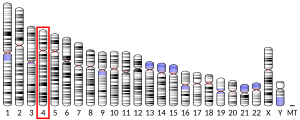APBB2
Izgled
Član 2 porodice B amijeloidnog beta A4 protein-vezujućeg prekursora jest protein koji je kod ljudi kodiran genom APBB2 sa hromosoma 4.[5][6]
Aminokiselinska sekvenca
[uredi | uredi izvor]Dužina polipeptidnog lanca je 758 aminokiselina, а molekulska težina 83.374 Da.[7]
| 10 | 20 | 30 | 40 | 50 | ||||
|---|---|---|---|---|---|---|---|---|
| MSEVLPADSG | VDTLAVFMAS | SGTTDVTNRN | SPATPPNTLN | LRSSHNELLN | ||||
| AEIKHTETKN | STPPKCRKKY | ALTNIQAAMG | LSDPAAQPLL | GNGSANIKLV | ||||
| KNGENQLRKA | AEQGQQDPNK | NLSPTAVINI | TSEKLEGKEP | HPQDSSSCEI | ||||
| LPSQPRRTKS | FLNYYADLET | SARELEQNRG | NHHGTAEEKS | QPVQGQASTI | ||||
| IGNGDLLLQK | PNRPQSSPED | GQVATVSSSP | ETKKDHPKTG | AKTDCALHRI | ||||
| QNLAPSDEES | SWTTLSQDSA | SPSSPDETDI | WSDHSFQTDP | DLPPGWKRVS | ||||
| DIAGTYYWHI | PTGTTQWERP | VSIPADLQGS | RKGSLSSVTP | SPTPENEKQP | ||||
| WSDFAVLNGG | KINSDIWKDL | HAATVNPDPS | LKEFEGATLR | YASLKLRNAP | ||||
| HPDDDDSCSI | NSDPEAKCFA | VRSLGWVEMA | EEDLAPGKSS | VAVNNCIRQL | ||||
| SYCKNDIRDT | VGIWGEGKDM | YLILENDMLS | LVDPMDRSVL | HSQPIVSIRV | ||||
| WGVGRDNGRD | FAYVARDKDT | RILKCHVFRC | DTPAKAIATS | LHEICSKIMA | ||||
| ERKNAKALAC | SSLQERANVN | LDVPLQVDFP | TPKTELVQKF | HVQYLGMLPV | ||||
| DKPVGMDILN | SAIENLMTSS | NKEDWLSVNM | NVADATVTVI | SEKNEEEVLV | ||||
| ECRVRFLSFM | GVGKDVHTFA | FIMDTGNQRF | ECHVFWCEPN | AGNVSEAVQA | ||||
| ACMLRYQKCL | VARPPSQKVR | PPPPPADSVT | RRVTTNVKRG | VLSLIDTLKQ | ||||
| KRPVTEMP |
Funkcija
[uredi | uredi izvor]Protein kodiran ovim genom stupa u interakciju sa citoplazmatskim domenima amiloid-beta (A4) prekursorskog proteina i amiloid-beta (A4) prekursorskog proteina 2. Ovaj protein sadrži dva vezujuća fosfotirozinska (PTB) domena, za koje se smatra da funkcioniraju u transdukciji signala.[8]
Reference
[uredi | uredi izvor]- ^ a b c GRCh38: Ensembl release 89: ENSG00000163697 - Ensembl, maj 2017
- ^ a b c GRCm38: Ensembl release 89: ENSMUSG00000029207 - Ensembl, maj 2017
- ^ "Human PubMed Reference:". National Center for Biotechnology Information, U.S. National Library of Medicine.
- ^ "Mouse PubMed Reference:". National Center for Biotechnology Information, U.S. National Library of Medicine.
- ^ McLoughlin DM, Miller CC (Jan 1997). "The intracellular cytoplasmic domain of the Alzheimer's disease amyloid precursor protein interacts with phosphotyrosine-binding domain proteins in the yeast two-hybrid system". FEBS Lett. 397 (2–3): 197–200. doi:10.1016/S0014-5793(96)01128-3. PMID 8955346.
- ^ Blanco G, Irving NG, Brown SD, Miller CC, McLoughlin DM (Jun 1998). "Mapping of the human and murine X11-like genes (APBA2 and apba2), the murine Fe65 gene (Apbb1), and the human Fe65-like gene (APBB2): genes encoding phosphotyrosine-binding domain proteins that interact with the Alzheimer's disease amyloid precursor protein". Mamm Genome. 9 (6): 473–5. doi:10.1007/s003359900800. PMID 9585438. S2CID 31066473.
- ^ "UniProt, Q92870" (jezik: engleski). Pristupljeno 22. 10. 2021.
- ^ "Entrez Gene: APBB2 amyloid beta (A4) precursor protein-binding, family B, member 2 (Fe65-like)".
Dopunska literatura
[uredi | uredi izvor]- Guénette SY, Chen J, Jondro PD, Tanzi RE (1996). "Association of a novel human FE65-like protein with the cytoplasmic domain of the beta-amyloid precursor protein". Proc. Natl. Acad. Sci. U.S.A. 93 (20): 10832–7. doi:10.1073/pnas.93.20.10832. PMC 38241. PMID 8855266.
- Bruni P, Minopoli G, Brancaccio T, et al. (2002). "Fe65, a ligand of the Alzheimer's beta-amyloid precursor protein, blocks cell cycle progression by down-regulating thymidylate synthase expression". J. Biol. Chem. 277 (38): 35481–8. doi:10.1074/jbc.M205227200. PMID 12089154.
- Strausberg RL, Feingold EA, Grouse LH, et al. (2003). "Generation and initial analysis of more than 15,000 full-length human and mouse cDNA sequences". Proc. Natl. Acad. Sci. U.S.A. 99 (26): 16899–903. doi:10.1073/pnas.242603899. PMC 139241. PMID 12477932.
- Chang Y, Tesco G, Jeong WJ, et al. (2004). "Generation of the beta-amyloid peptide and the amyloid precursor protein C-terminal fragment gamma are potentiated by FE65L1". J. Biol. Chem. 278 (51): 51100–7. doi:10.1074/jbc.M309561200. PMID 14527950.
- Gerhard DS, Wagner L, Feingold EA, et al. (2004). "The Status, Quality, and Expansion of the NIH Full-Length cDNA Project: The Mammalian Gene Collection (MGC)". Genome Res. 14 (10B): 2121–7. doi:10.1101/gr.2596504. PMC 528928. PMID 15489334.
- Li Y, Hollingworth P, Moore P, et al. (2006). "Genetic association of the APP binding protein 2 gene (APBB2) with late onset Alzheimer disease". Hum. Mutat. 25 (3): 270–7. doi:10.1002/humu.20138. PMID 15714520. S2CID 28343972.
- Lange A, Thon L, Mathieu S, Adam D (2005). "The apoptosis inhibitory domain of FE65-like protein 1 regulates both apoptotic and caspase-independent programmed cell death mediated by tumor necrosis factor". Biochem. Biophys. Res. Commun. 335 (2): 575–83. doi:10.1016/j.bbrc.2005.07.125. PMID 16083851.
- Rual JF, Venkatesan K, Hao T, et al. (2005). "Towards a proteome-scale map of the human protein-protein interaction network". Nature. 437 (7062): 1173–8. doi:10.1038/nature04209. PMID 16189514. S2CID 4427026.
- Hong Q, Hsu LJ, Schultz L, et al. (2007). "Zfra affects TNF-mediated cell death by interacting with death domain protein TRADD and negatively regulates the activation of NF-κB, JNK1, p53 and WOX1 during stress response". BMC Mol. Biol. 8: 50. doi:10.1186/1471-2199-8-50. PMC 1904229. PMID 17567906.
Vanjski linkovi
[uredi | uredi izvor]- Lokacija ljudskog genoma APBB2 i stranica sa detaljima o genu APBB2 u UCSC Genome Browseru.








